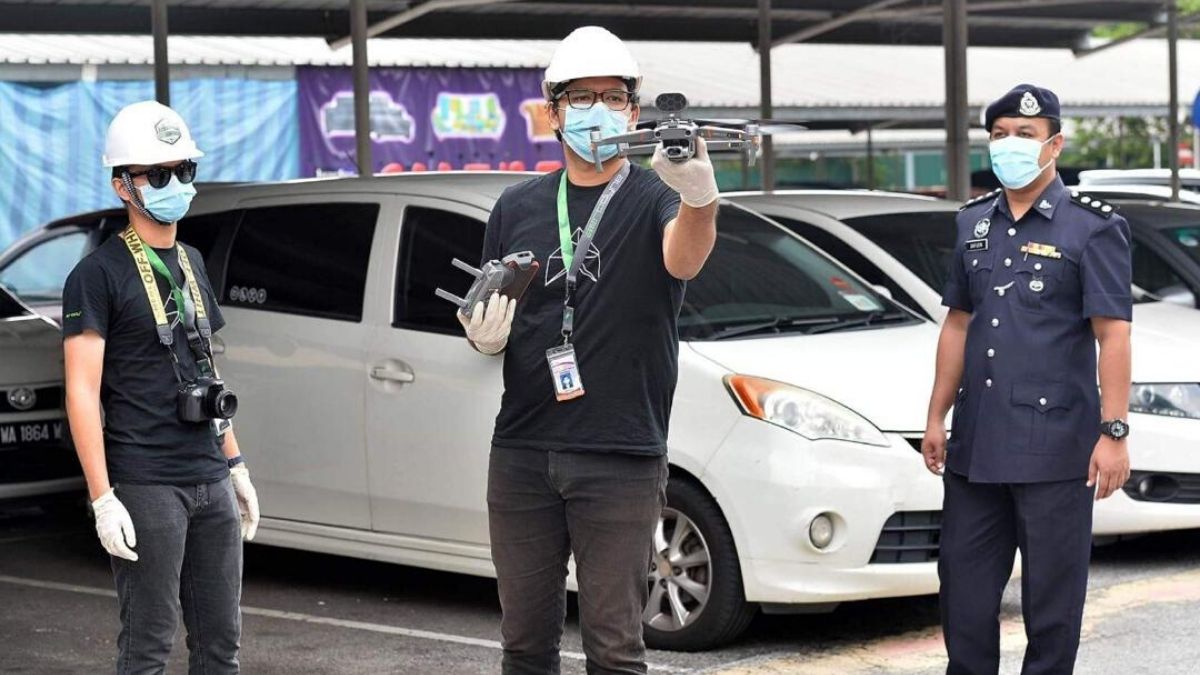On April 7, it was announced that 92 drones would be deployed throughout the country during the second phase of the Movement Control Order (MCO) after approval from the Civil Aviation Authority of Malaysia (CAAM).
The Royal Malaysia Police (PDRM) was authorized to operate the drones for surveillance and enforcement throughout this duration.
The operation is led by the police in collaboration with the Malaysian Armed Forces (ATM) and three private Malaysia-based drone companies—Aerodyne Group, DefTech Unmanned Systems, and System Consultancy Services, all of whom are lending their services as part of CSR efforts.
Vulcan Post reached out to Aerodyne Group to learn more about the workings of the operation and what they’ve managed to achieve so far.
Experience counts
We spoke to Kamarul Muhamed, founder and group CEO of Aerodyne, and he told us that 54 of the 92 drones belong to Aerodyne.
In fact, two weeks ago, they were already operating their drones under PDRM to help out with the first phase. “We were approached by them and given the permission to operate under them, and at the same time they were requesting CAAM approval,” Kamarul recalled. “But of course, at that time, it was a smaller team to just help out during the emergency situation, and now we’ve actually expanded the team.”
As it’s a risky operation, accountability, professionalism, and experience all counted, and so the authorities chose the three companies based on their track records.
“We’re a five-year-old company with operations in 25 countries, and we have certified pilots from Australia, the UK, the US—so we have a large crew, of which almost 80 of them are pilots,” Kamarul said.
Multipurpose drones
“The use of drones is about ensuring separation and compliance with the MCO, because that’s the only way we can flatten the curve.” However, Kamarul also said that drone usage during the COVID-19 pandemic could be classified into four main uses.
First would be for monitoring, patrolling, and crowd control, along with temperature monitoring of crowds. This, he said, is already being done in Malaysia, and Aerodyne has equipped its drones with thermal cameras at roadblocks to detect the temperature of passengers.
The three other uses for drones globally that aren’t being practised in Malaysia are mass sanitation, deliveries, as well as security and surveillance.
The effectiveness of using drones for sanitation on roads in particular is arguable, Kamarul said, but he believes that if they were used to sanitize a compound or place of worship, it could do some good.
So far, the Malaysian government has not authorized the use of drones for deliveries or for security and surveillance around facilities with critical assets.
An unmatched advantage
Currently, the drones are mainly being used in the populated Klang Valley, even though Aerodyne has received the Notice to Airmen (NOTAM) approval by CAAM to operate nationwide.
While ATM is doing some drone monitoring in Penang and Johor, among other places, Klang Valley is the only one with full-coverage drone monitoring for now.
While the police can still monitor by car, the difference is major, according to Kamarul. “A single drone can cover in one hour what a fleet of 30–40 policemen in a bunch of cars can monitor.”
If the situation worsens, they would need to deploy two to four drone operator teams in every major city.
The drones collect visual and thermal data, which are then geotagged for Aerodyne and the other companies to conduct statistical analyses about the risks in specific areas and identify hot zones.
As for how the situation is currently looking, he shared, “To date, we have done more than 500 missions. Based on the data that we have so far, roughly 10% of the population in Klang Valley is still non-compliant, and 8% involve observational risks which resulted in the police making announcements.”
“There have been cases where we were able to find escape routes of non-compliant people. As a result, the whole area became a red zone,” Kamarul said.
The monitoring is done daily from 8:00 a.m. until 10:00 p.m., unless there’s an emergency, during which the hours may extend past midnight.
During our interview, Kamarul made sure to thank his team as this was a voluntary effort, yet none of them withdrew.
Navigating risks and concerns
There are all kinds of risks involved when operating drones. The drones may fall on people, or some bystanders may throw objects at them.
Thus, Aerodyne is operating smaller drones to minimize the overall risks. With most of aircraft grounded, they simply have to coordinate their operations with police helicopters.
And what about worries of drones driving an invasion of privacy? Kamarul replied, “I think this is the responsibility of all stakeholders. We are all heading towards a drone economy.”
He described a drone economy as a time in the near future when drones become a part of everyday life—for deliveries, safety, hobbies, and even virtual tourism. “This is a vision of three to four years away, but before we get there, we need to have public acceptance. The technology is already there.”
We already have rules in place to protect our privacy under Malaysia’s Civil Aviation Regulations 2016, with a revision to come soon. No-fly zones have been defined, and under Section 143 (1), drones cannot come within 150 meters of buildings or 50 meters of a person.
What’s left to do is to disseminate the information, Kamarul said, and every stakeholder has a part to play. The media should have more discussions about this, drone companies have to comply with the regulations, and the authorities should have friendlier rules that support innovation.
Overall, the punishments for non-compliance of the regulations are severe, but more work needs to be done to enforce them and to spread awareness, he believes.
